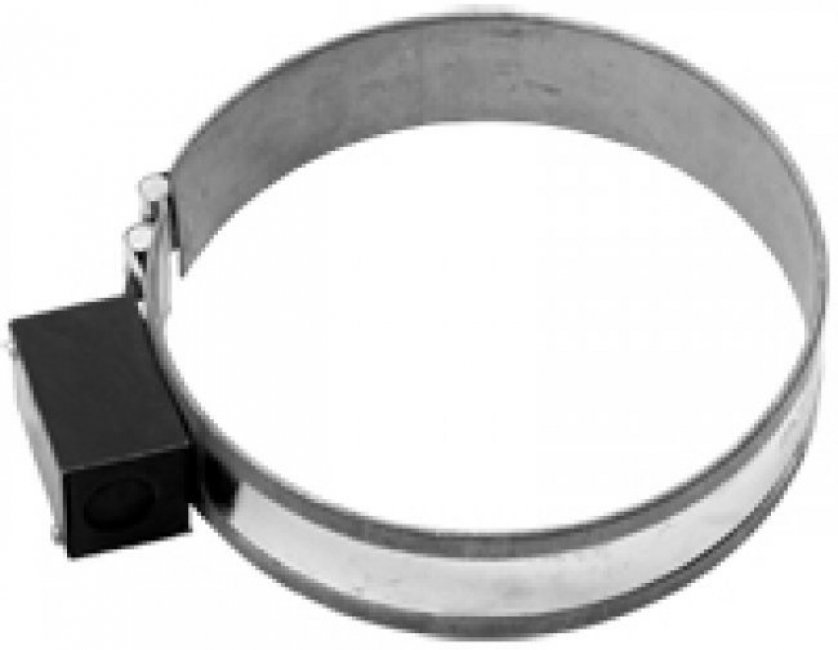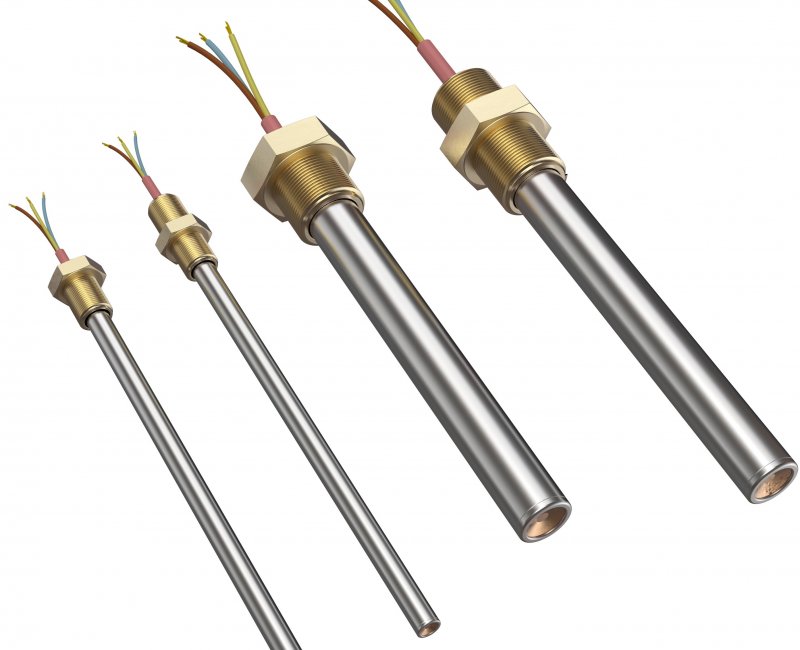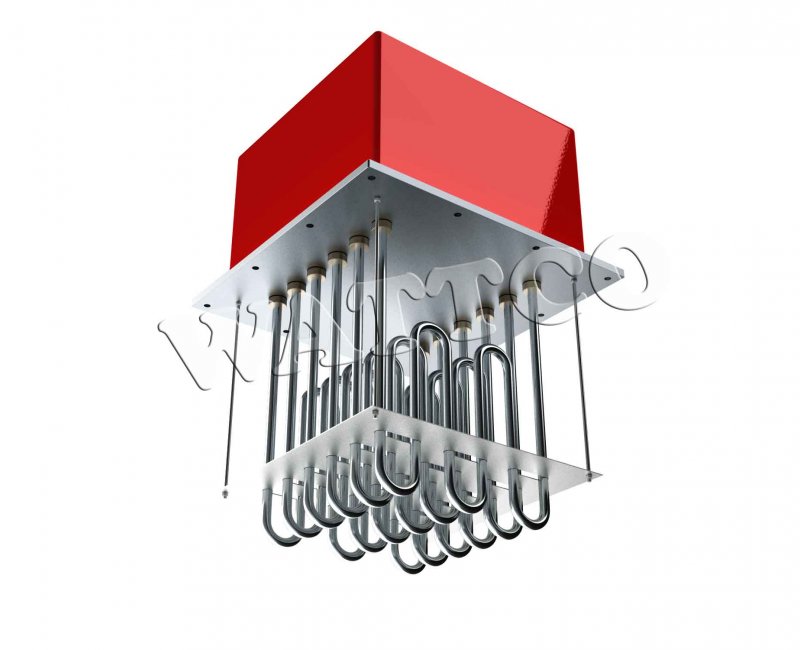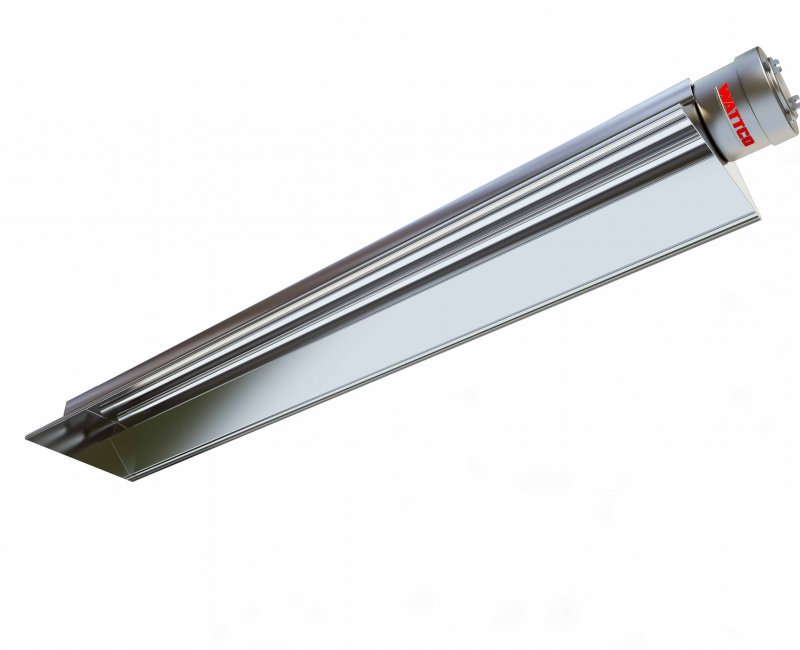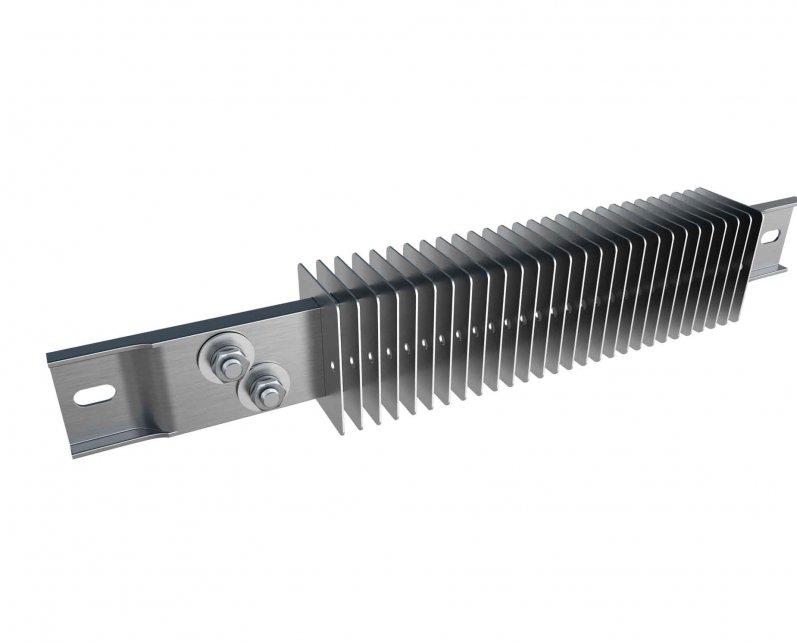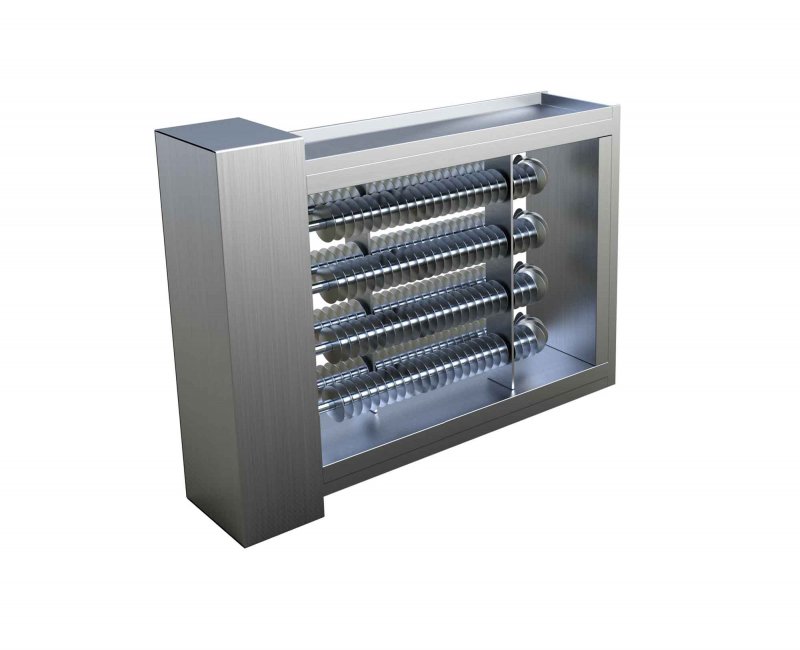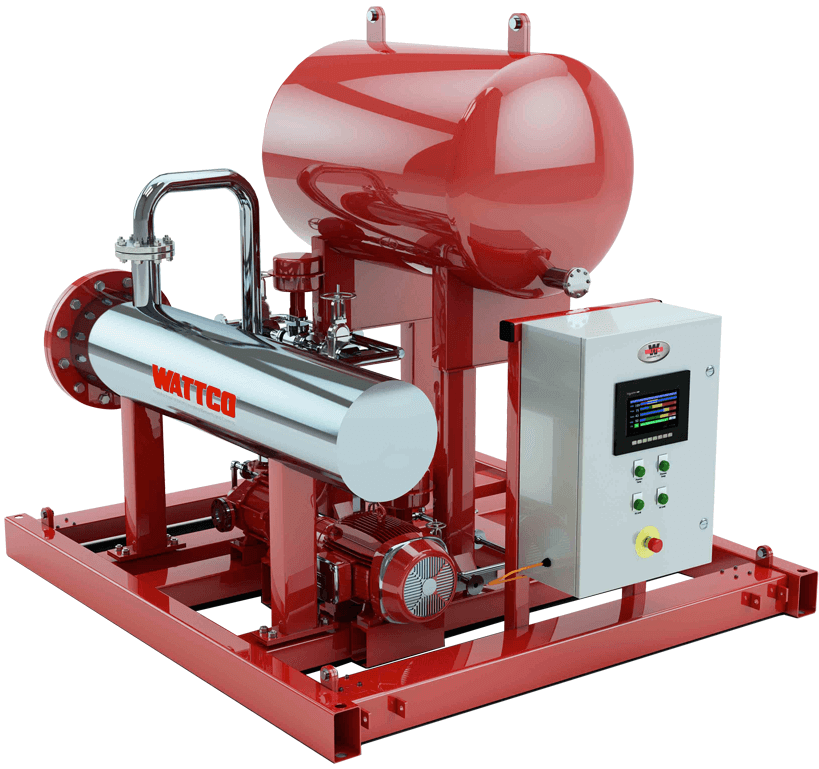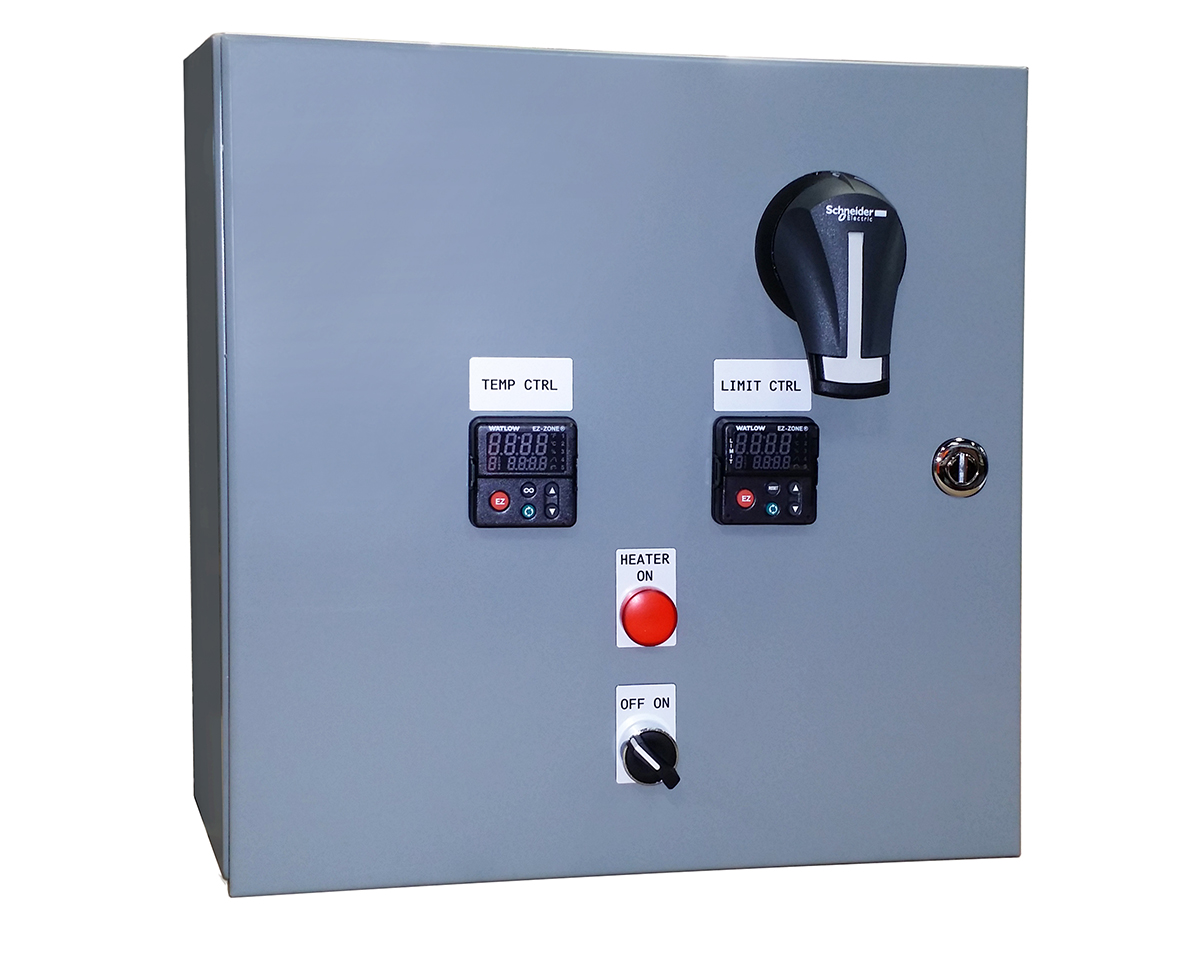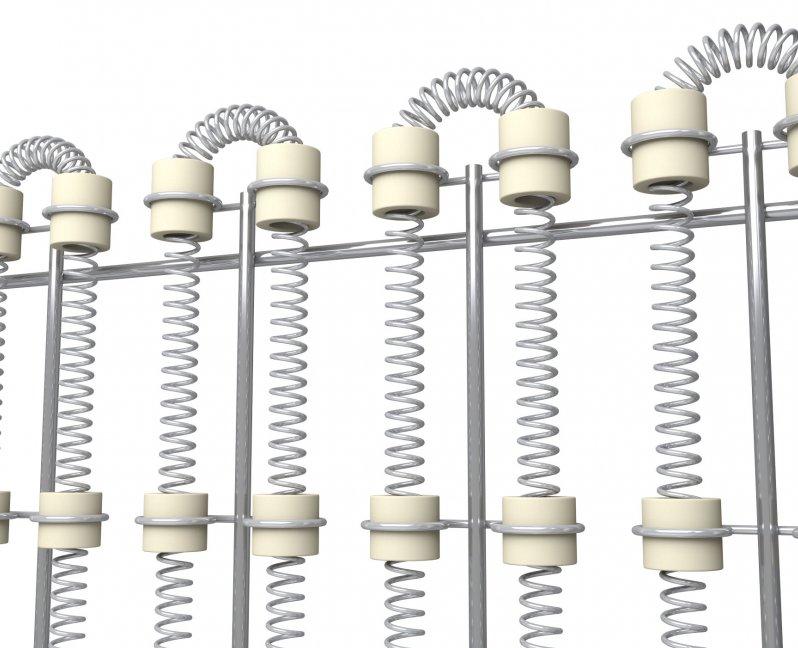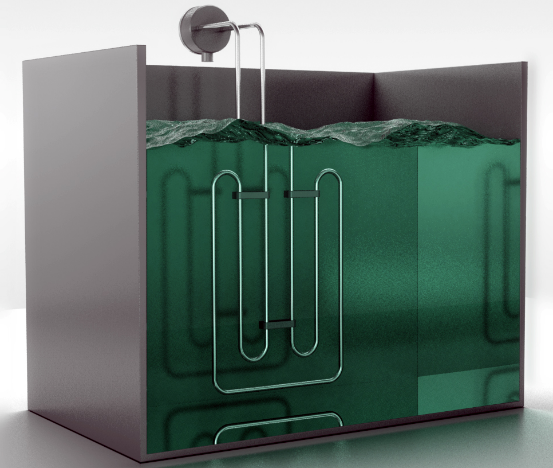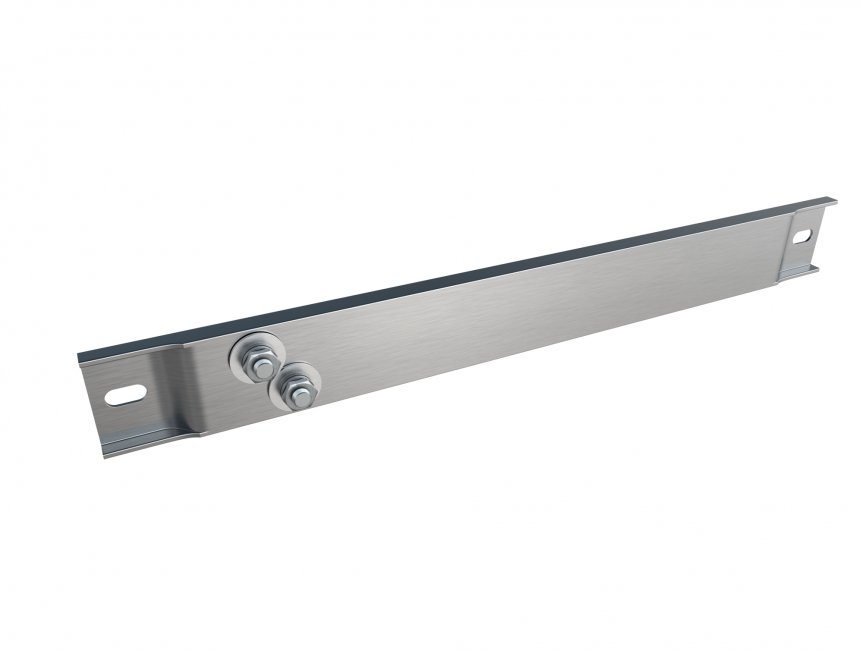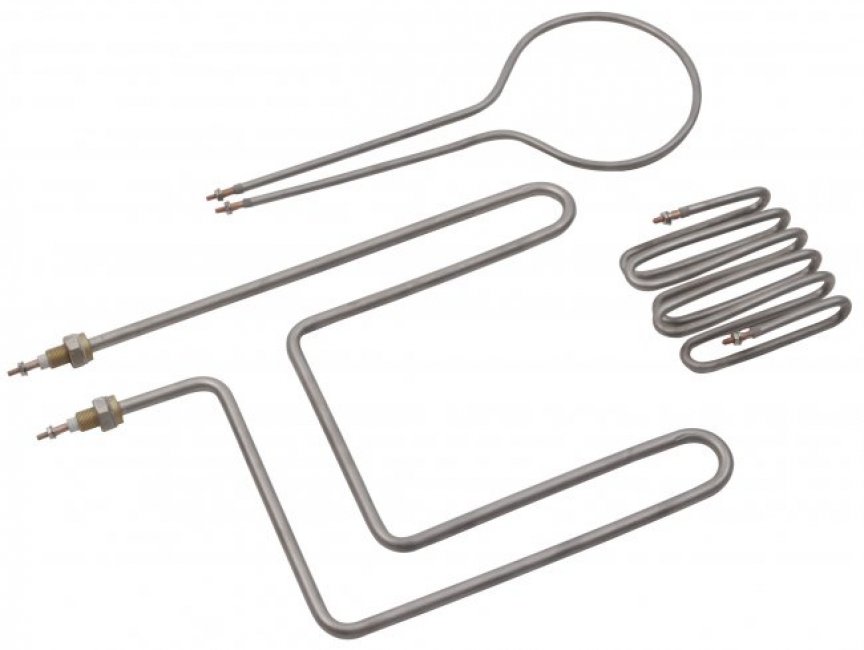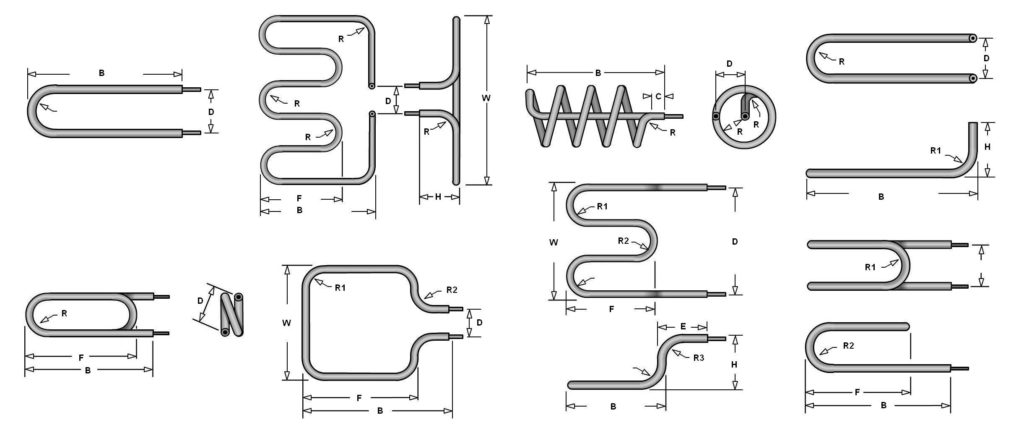Search Results
Tanks requiring industrial tank heaters can utilize indirect heating with band heaters or, they can use direct heating that typically uses some form of immersion heating. Indirect Heating WATTCO Band heaters can be found in several types of dimension, wattage, voltages and material.
Mica band heaters are an inexpensive industrial heating solution that surrounds pipes and tubes that require external indirect heating. Pipe heating, drum heating, barrel heating normally used for oils, lubricants or any other circular applications.
Band Heaters Uses
Band heaters use electric heating elements (NiCr wire) to heat-up the external surface of drums or pipes for a gradual heat transfer. Band heating is an indirect form of industrial heating and offers safety when heating volatile and explosive substances as well as pipes or containers that cannot otherwise be heated using direct heating methods.
Industrial band heaters can be made with NEMA 1 terminal boxes or NEMA 4 moisture resistant terminal boxes that protect terminations and have the option of a thermostat or thermocouple digital temperature controllers to help control and regulate an applied heat.
Insulation is also required to help direct the heat to your application rather than experience heat loss, and slow heat-up time. Band heaters from WATTCO are the ideal solution for high watt densities and high operating temperature applications, especially for the plastics industry.
The various types of band heaters available at WATTCO include mica insulated band heaters and ceramic band heaters. Direct Heating For direct heating, our immersion heaters section is suggested as a more efficient means for heating your liquids.
Direct heating uses flanged heaters, screw plug heaters, over the side heaters as well as pipe heaters Get a quote on a band heater today.
WATTCO also manufactures other industrial heating products such as infrared heaters, control panels, circulation heaters and more. Click here to view all of our products
Cartridge heaters can be considered “component heaters” that are used to generate heat in many different applications. These process heaters are primarily used in mold and fit snug inside a cavity and helps heat solids by reaching high temperatures. Cartridge heaters have the versatility of being able to carry thermocouple inside to help control temperatures of the heater more accurately.
Various diameters allow for it to be used in any cavity and can be custom designed with any cold section. Lead wires extend from the end to your control panels.
Cartridge heaters uses
Cartridge heaters are used as a water heater element and in a wide variety of applications. Some of these uses include bag sealing applications, hydraulic oil applications, motor oil applications, gearboxes, water heating applications as well as laboratory and food equipment.
Sheaths can reach extreme temperatures as cartridge heaters can be designed with higher watt densities. High watt density cartridge heaters can also have different types of lead wire connections. For more mechanical processes, stainless steel braided leads are used against mechanical stress. BX cabling can be used for added protection, though it reduces the lead wire flexibility.
Terminal pins are also available on all models. Cartridge heaters from Wattco are made of a swaged construction that consists in a high-grade nickel chromium resistance wire wound around a high-quality MgO core that is centered in a stainless steel casing. Cartridge heaters are used for heating metal parts and can also be fitted with threaded bushings for liquid heating for certain applications.
Cartridge heaters are ideal heating solutions for a wide range of industrial applications. They provide reliable heat for injection molding, packaging machinery, and die-casting. It has a compact design that fits in tight spaces like heating plates, molds, and sealing bars. They are used to preheat engines and warm fluids in the automotive and aerospace industries.
They also play an important role in food processing, medical devices, and semiconductor manufacturing by maintaining consistent temperatures. These heaters are durable, customizable, energy efficient, and used for diverse industrial operations.
Cartridge heaters will reach metal temperatures of up to 1,400ºF (760ºC) with the appropriate material, watt density, and fit selections (see Figure 2 on our catalog page 7.2).
Get a quote on a cartridge heater today. WATTCO also manufactures other industrial heating products such as infrared heaters, immersion heaters, pipe heaters and more. Click here to view all of our products.
WATTCO™ duct heaters come in various sizes and dimensions to fit any compartment. Three types of duct heaters are available: open coil, tubular or finned tubular heating elements that are either flanged or inserted in the duct.
Air duct heaters primarily use in air-flowing ventilation systems and comfort-heating applications. Process duct heaters mainly serve industrial process heating applications (ovens that require re-circulated air or forced circulation).
Wattco™ duct heater features
WATTCO™ designs and configures your electric heating element according to your specifications. Our team is dedicated to research and development, using the latest technologies while striving to meet every customer’s needs by manufacturing high-quality industrial heating products.
Since 1969, WATTCO™ has earned a reputation for expertise in developing and manufacturing electrical heating elements that make Wattco duct heaters the most easily adaptable industrial heating solution for most non-pressurized, air-heating systems
Duct heaters control temperature in HVAC systems.
- Energy Efficiency: Precise temperature regulation reduces the energy waste. Integrated with advanced controls for optimized energy usage.
- Versatility: Heat air in ventilation systems in food processing, pharmaceuticals, and chemical processing. Available in custom sizes and wattages and fit to industrial needs.
- Process Heating: Heat air streams for drying, curing, or sterilization in industrial processes.
- Durability: Highly durable in high moisture and corrosive conditions.
- Safety: Offers thermal cutoffs and temperature and temperature controls.
- Wattco duct heater Usage
Also read: Duct Heating in HVAC and Building Construction
Duct heaters are electric heating devices installed within air ducts to provide localized heating in HVAC systems. Its applications include:
1. Commercial Spaces
Duct heaters are mostly used in commercial buildings to maintain indoor temperatures, particularly in large open areas where standard heating is insufficient.
Example: In a shopping mall, duct heaters are installed in the HVAC system to produce warm heat to areas such as food courts or atriums, regardless of outdoor temperatures. It provides a pleasant shopping experience and longer visits.
2. Industrial Applications
Many industries require a temperature control to offer smooth equipment’s operation and maintain safety hazards.
Example: In a manufacturing plant like chemical or plastics, duct heaters are necessary to maintain the air temperature within a specific range and to avoid product damage or defects due to cold elements.
3. Ventilation Systems
During colder climates, the duct heaters are effective in preheating the incoming air in ventilation systems.
Example: In an office building, the duct heater can be fixed in the fresh air intake line to heat the incoming air before it enters the occupied spaces. This improves indoor comfort and energy savings by reducing the load on the main heating system.
4. Zone Heating
Duct heaters enable target heating at specific zones of larger spaces and also help for better energy management.
Example: In a warehouse with different usage levels, a duct heater can be installed in an area where the meetings and gatherings are hosted. It makes that area get heated independently and saves energy when the space is not in use.
5. Dehumidification
Duct heaters can control humidity levels by heating the air to reduce the moisture.
Example: In a swimming pool, a duct heater can be used to heat the indoor pool air. The warm air can reduce moisture and offer a comfortable environment by preventing mold growth and condensation on surfaces.
Wattco™ duct heater voltages
A broad range of custom-built electric duct industrial heaters with capacities up to 1000kW is available upon request. WATTCO™ heaters are ideal for applications with the following voltages
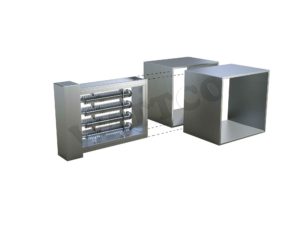
- 347 volts/1 phase
- 600 volts/1 phase
- 600 volts/3 phases
- 208/240 volts/1 phase
- 208 volts/3 phases
WATTCO™ duct heaters have the international, American recognized Canadian Standards Association (CSA us) label, which sets the standards for the electric heating industry. Duct heaters can include proper built-in safety devices to extend the heater’s service life. Get a quote on a duct heater today.
WATTCO also manufactures other industrial heating products such as infrared heaters, control panels, immersion heaters, and more.
Industrial infrared heaters uses
Electric Infrared Radiant Heaters Uses
- Medical
- Automotive
- Mining/Oil/Gas
- Construction/Manufacturing
- Thermoforming
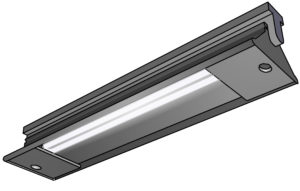 Medical
Medical
Automotive
Infrared radiant heaters have influenced auto manufacturers to realize their benefits in the automotive panel manufacturing projects. Since the workable manufacturing areas was recessed and tight to work within, industrial heating solution manufacturers tried to simplify the problems in using adhesive materials. They designed a form of infrared radiant heating that is capable of drying and annealing two parts together in a shorter time period.
Mining/Oil/Gas
The mining, oil and gas industries have found the best ways to increase their productivity and allowed companies to enhance the quality of products they are manufacturing. They can now combine infrared and microwave heat to clean the oil laced sand from the crude oil tanks.
Construction/Manufacturing
Infrared radiant heaters can be used for creating construction materials that require demanding environments involving extreme temperatures and processing plants. They are helpful in binding different materials together so that something new and worth using can be created, which can satisfy both domestic and industrial needs.
Packaging
Infrared electrical heating elements are used to improve thermoforming efficiency to help companies accomplish numerous objectives. Manufacturers normally create complete systems having maximum control according to the market demands.
Thermoforming
The plastic thermoforming industry is another place where, infrared radiant heaters are frequently used due to their ability of maximizing quality and efficiency of the companies. The heaters are known to reduce average expenses on thermoforming, thus affecting the profit margin of users up to 40 percent.
Importance of Electric Infrared Radiant Heaters for Industrial Purposes
- Electric Infrared heaters are used in industries for heating purposes. It works by emitting infrared radiation, that transfer the heat to the objects directly and surfaces without heating the surrounding air and make them energy efficient.
- Used in the processes of drying, curing, and heating in the industries like automotive, textiles, and printing. It offers uniform and controlled heating which increase the product quality.
- Infrared heaters are energy efficient that transfer the heat to the target and reduces the energy waste and operational costs.
- It provides instant heat and cutting down process times in paint curing or material preheating applications.
- Used in food processing and maintain consistent temperature for baking and sterilization.
- Infrared heaters are highly durable with less maintenance.
Finned strip heaters, often considered component heaters, are an electric heating element that maximizes heat intensity and transfer effectively in an area. Steel fin strip heaters are an excellent industrial heating product that can be easily controlled by using a heating control panel, mechanical thermostat or cost effective bi-metal thermostats that can be installed on the surface of the heater.
Mounting holes are useful to mount the heaters securely on the wall housing with terminal extending from the sheath for easy electrical connections. Many users also request lead wires that extend from one end that make the installation more flexible as the temperature controller is easily adaptable to this configuration.
Temperatures can reach as high as 500 degrees F and use the high quality magnesium oxide that is also used in tubular heating elements that allow for effective heat transfer. Finned strip heaters are a fairly inexpensive way of heating small areas and are an excellent solution to meet any budget.
Finned strip heaters are composed of a heating element, a protective sleeve or sheath, and mounting hardware along with steel finned that are used to extend surface area. If strip heaters are used as a radiant heater, or a duct heater, they have can have fins to maximize surface area and heat transfer to the air.
Also read: Finned Tubular vs Open Coil Heater Elements
Strip heaters can be clamped or bolted onto objects or solid surface contact heating over large areas and are primarily used in indoor applications. Get a quote on a finned strip heater today. WATTCO also manufactures other industrial heating products such as infrared heaters, immersion heaters, pipe heaters and more. Click here to view all of our products
Finned tubular heating elements from WATTCO™ are the most versatile and dependable electric heating element available today. These industrial heating solutions are among the most common heaters and are best suited for a large number of applications such as conduction, convection, and radiation.
Finned tubular heating
WATTCO™ factory-configures every finned tubular heater to almost any shape or size. Custom bending diameters can be made upon request. WATTCO uses the finest materials in construction such as steel, stainless steel, incoloy, inconel and/or titanium alloys. WATTCO also uses high quality magnesium oxide to allow for efficient heat transfer from resistive coil to your heating medium whether it is air, liquid or solid.
These heater elements have a strong outer sheath to help protect the heater from physical stress and uses high quality alloys to allow efficient heat transfer from resistance coil to your heating medium. Depending on their rating, sheath and shape, WATTCO™ electric tubular elements are used in a variety of heat applications that require process temperatures of up to 750°C (1 382°F) to heat liquids, gases and solids.
Also read: Finned Tubular vs Open Coil Heater Elements
A variety of diameters are available to help adjust watt densities in your application to design these electric heaters for best performance and long life. Standard and custom made terminal pins allow for easy installation and maintenance. Bending radiuses are designed with careful expertise to allow for optimal performance when meeting “form fit and function” within your application.
Get a quote on a tubular heater today. WATTCO also manufactures other industrial heating products such as infrared heaters, immersion heaters, circulation heaters and more. Click here to view all of our products. 
Industrial immersion heaters are a fast and efficient way of heating up various liquid solutions in processing equipment, as well as in large tanks through the use of tank immersion heaters.
Heating up liquids using direct heat transfer allows for the liquid medium to quickly reach the desired temperature using electric heating elements such as flanged heaters, screw plug heaters, over the side heaters or immersion water heaters.
This application is commonly used in chemical processes, large petrochemical containers as well as large water containers that require fast heat up time. With minimal maintenance requirements, immersion heaters are an excellent solution to rapid heating in almost any industrial environment.
The use of electric immersion heaters has been more popular in the past several decades as rising costs of fuels (and the necessary infrastructure that comes with it) force individuals to select a more cost efficient way of heating their applications.
Ecologically conscientious groups have long advocated for cleaner energies to help save the environment. Wattco immersion heaters have been known to use the cleanest form of energy, leaving no residual discharge and provide immediate heat transfer to any medium.
Also read: Immersion Heater Maintenance: How To Maximize Lifespan & Efficiency
Types of industrial immersion heater
WATTCO manufactures a variety of immersion heaters including flanged immersion heaters, circulation heaters, inline heaters, and over-the-side heaters.
https://www.youtube.com/watch?v=je61phStrLE
Flanged Immersion Heaters
Flanged immersion heaters have the ability to hold multiple hairpin elements that can be mounted onto the side of a container (commonly referred to as a tank immersion heater). Its versatility allows it to offer up to 750 KW of power on a single unit. Among its various uses include utility companies, defence contractors, petrochemical researchers and boiler manufacturers.
Learn more about our Flanged Immersion Heaters 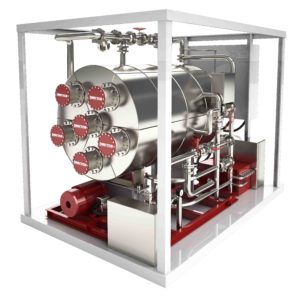
Circulation Heaters (or In Line Heaters)
Circulation heaters (or In Line Heaters) use flanged immersion heaters or screw plug heaters within a vessel chamber to heat up liquids from an inlet and expels the heated liquid through an outlet using the force of a pump to allow easy circulation.
The circuit of running liquid is then reheated to reach a target temperature. It is often referred to as the most efficient use of electric heating as heat is initially applied to liquid at ambient temperature, but then recirculated at an elevated temperature that does not require as much energy to reach your target temperature.
The use of insulation around piping and the tank itself allows the heat to be contained. The circulation vessel is often reinforced with high quality insulation that helps prevent heat loss.
Coupled with the use of a high quality alloy that prevents heat loss (high grade stainless steel) the unit is a complete system that allows users to use thermocouples, RTD temperature sensors or standard mechanical thermostats to maintain liquids at optimum temperatures.
Also read: Alternatives to Direct Immersion Heaters
Safety sensors are also available such as high temperature sensors to help prevent excessive heat or over temperatures. This protects both the liquid you are heating as well as protection to your industrial heater.
Use of Immersion heaters
- Chemical Processing: It heats chemicals, acids, and other liquids in storage tanks and reactors and maintains their temperature.
- Oil and Gas Industry: Heats the crude oil and hydrocarbons, maintains the viscosity of oils, lubricants, and fuels, and prevents freezing.
- Water Treatment Plants: Allows heating water for coagulation and flocculation.
- Food and Beverage Industry: It heats water, oils, or other liquids for cooking, sterilization, and cleaning.
- Metal and Machinery Industry: Heats degreasers to remove contaminants from machinery.
- Power Generation: Heats fluids in boilers for steam production.
- Renewable Energy Systems: Act as a backup heater in solar thermal systems.
Learn more about our circulation heaters
Learn more about our in-line heaters
Over-The-Side Heaters
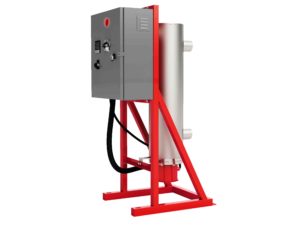
Over-the-side heaters are used to heat up larger containers of liquid that have openings. Immersion heaters and tank immersion heaters are often available with several different ranges of temperatures that can be fine tuned for extreme accuracy.
As such, very tight and efficient control can be maintained which has a positive effect on the performance of the industrial heater plant. Along with this, several mounting options can be also be availed which further facilitate processes.
Examples include screw plug connections, over the side designs, 3 phase immersion heaters, immersion water heaters and flanges. There are several options for piping as well such as flanged, welded or threaded.
Also read: Immersion Heaters: Installation and Maintenance Tips
Get a Quote on an Immersion Heater Today
WATTCO also manufactures other industrial heating solutions such as infrared heaters, screw plug heaters, pipe heaters and more. Click here to view all of our products.
Solid State Power Switching devices are underappreciated in the arena of temperature control panels. Yet, the fact that they are overlooked cannot create doubts about their usefulness and need in the operations.
Advantages of Hybrid Temperature Control Panels
Solid-state switching devices are semiconductors that control the power, either voltage or current, supplied to the production system. While their job is primarily to switch the power on and off at a rapid pace according to the controller’s instructions, they can do multiple standalone functions that primarily include diagnostic and supervisory functions.
They can be seen in a similar light to electronic circuit breakers because of their ability to protect the system from damage caused by unchecked temperature settings or power supplies. Their reliability and ability to easily manage fast-paced switching operations increase their functionality and demand in the market.
They are best utilized in low-noise areas and in areas that are switched frequently, for example to control resistive loads, conveyor systems, etc. Their compact design makes them a viable choice for use in control cabinets, allowing for greater space availability.
There are a number of outputs that are used with temperature and process controllers, some of the common ones include, solid state relay drivers, linear along outputs, relay outputs, and triac. The relay output commonly is a single pot double throw relay which comes with a DC voltage coil.
The controller works by isolating the contacts using the energy added to the relay coil. This lets the contacts make use of the external voltage source, which ultimately powers the larger heating contactor. The contacts used in the process are designed to control the output in addition to handling the process timing and proper execution.
Temperature and process controllers are an integral part of the workings of a number of industries. The best industrial functions need proper maintenance of process schedules and temperature levels both of which are controlled by these controllers.
Food and Beverage Industry Packaging
The packaging industry is heavily dependent on temperature maintenance for proper functioning. The machinery used in packaging which includes hot melt functions, glue applicators, seal bars, label applicators, and shrink wrap tunnels are designed to operate at a certain temperature and to process for a set length of time. Both of these processes are regulated by temperature and process controls. Process controllers control the process time limit, while temperature controllers ensure that the wanted temperature is maintained throughout.
Food and beverage industry
The food and beverage industry is another place where temperature plays a vital role. The use of temperature and process controllers in the industry is for a variety of purposes such as blending, sterilization, brewing, cooking, baking ovens etc. Temperature and process controllers make sure that the temperature is regulated and optimum performance ensured.
Temperature Control Panels for the Plastic Industry
The plastic industry makes a slightly different use of temperature controllers than boilers or kilns. They look to use them in relation to controlling portable chillers, dryers, hopers, extruding equipment and molding. As far as the extruding equipment is concerned, the use of process controllers in combination with temperature controllers is to precisely monitor and control temperature at the different critical points in its operation.
Temperature Control Panels for Heat Treating Applications
One of the most common uses of temperature and process controllers are in heating ovens or in heat treating applications such as boilers, exchangers, ceramic kilns and different types of furnaces.
WATTCO Multistage Temperature Control Panels come with the On-Off panels with the following options:
24V transformer
Step Controller
Contactors and Fuses for multiple load variations
Option to have an SCR Contactor
Get a quote on a multistage temperature control panel today. WATTCO also manufactures other industrial heating products such as infrared heaters, circulation heaters and more. Click here to view all of our products.
Open coil elements are the most efficient type of electric heating element and the most economically feasible for most heating applications. Used predominantly in the duct heating industry, open coil heater elements have open circuits that heat air directly from the suspended resistive coils.
These industrial heating elements have fast heat up times that improve efficiency and have been designed for low maintenance and easily, inexpensive replacement parts.
Wattco open coil elements
Open coil heating elements from Wattco are typically made for duct process heating, forced air & ovens and for pipe heating applications. Open coil heater elements are made to fit inside standard 2’’ or 3’’ schedule 40 NPS pipe.
Open coil heaters are used in tank, pipe heating, and/or metal tubing. A minimum clearance of 1/8’’ is required between the ceramic and the inside wall of the tube. An open coil element will provide excellent and uniform heat distribution over a large surface area.
Open coil heater elements are an indirect industrial heating solution to decrease watt density requirements or the heat fluxes on the surface area of the pipe connected to the heated section and prevent heat-sensitive materials from coking or breaking down.
Also read: Finned Tubular vs Open Coil Heater Elements
Open coil elements are versatile, and used in industrial applications for efficient heat transfer. They consist of resistance wire wound into coils to heat air or gases in devices like forced-air duct heaters, ovens, and dryers. Their design provides quick heat response and even distribution, essential for processes requiring quick temperature adjustments.
These elements are highly used in space heating, industrial furnaces, and packaging equipment. Its features are adaptability, durability, cost-effectiveness, easy replacement, and customization for various wattages and sizes.
Get a quote for an open coil element today. WATTCO also manufactures other industrial heating products such as infrared heaters, control panels, circulation heaters and more.
Over the side (OTS) heaters are a popular industrial heating product due to their cost-efficiency and practicality. Using a water-resistant terminal housing, these industrial heaters come in many shapes and sizes to fit your tank’s dimensions and specifications.
Mobility
Wattco’s over the side immersion heaters are custom designed with multiple tubular elements and a thermowell to hold your temperature probe. Shaped to fit within your standard (or non-standard tank), the economic feasibility can meet the budget of any project manager. The mobility of these heaters allows for usage in multiple containers and can be a superior choice for many project managers.
Wattco™ over the side heater (OTS) features
Wattco™ uses high-quality stainless steel and other exotic alloys to meet the requirements of any application. With a digital control panel, this heater becomes the perfect solution for heating large containers with no access to the liquid except from the top. Brackets are used to support the heater onto the wall of the tank, and cold sections are carefully calculated to prevent overheating when water or liquid levels drop below certain levels as a result of evaporation or drainage.
Over the side (OTS) heater industrial uses
Using high-quality alloys, Wattco™’s over the side heaters are strong enough to physically withstand many harsh environments both indoors and outdoors. Commonly used in petroleum and chemical industries, it is an exceptional choice for projects with limited budgets.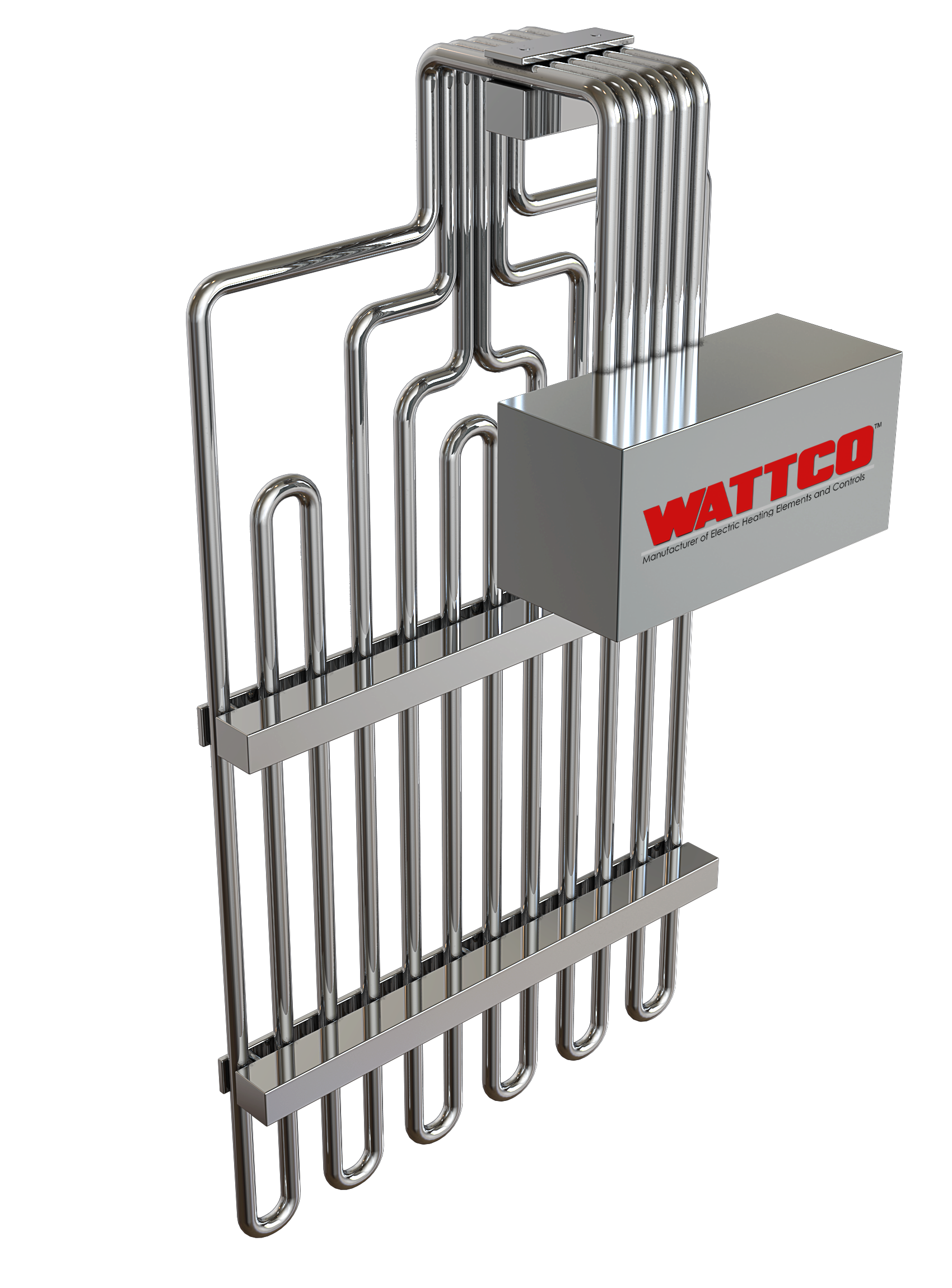
Wattco’s over the side (OTS) heaters advantages
Over the side immersion heaters are specifically designed to be installed in the upper portion of tanks. The substance to be heated is either below the industrial tank heater or onto one side, hence the name. The main advantages of this approach are that ample space is left in the tank for other operations to take place, and the heater can easily be removed when the required temperature is achieved within the substance.
The heating element of an over the side process heater is usually made from steel, copper, cast alloy and titanium. A coating of fluoropolymer or quartz can be provided for protection.
There are several applications in which over the side heaters can be used, such as heating oils of varying viscosities, degreasing solutions, heat transfer oils and caustic solutions.
Get a quote on an over the side heater today. Wattco™ also manufactures other popular industrial heating solutions such as infrared heaters, pipe heaters and circulation heaters. Click here to view all of our products.
Silicone rubber heaters from WATTCO™ are composed of fiberglass reinforced silicone rubbers that are moisture and chemical resistant. Thin and flexible, silicone rubber heater elements are designed to meet the requirements of various low and medium temperature applications that require irregular shapes, sizes, and dimensions.
WATTCO Silicone rubber heaters
Silicone heaters are known for their unique and flexible properties and can withstand mechanical shock and vibration. Silicone heaters have unique qualities such as a high dielectric strength, non-toxicity, and flame retardance. Silicone heaters consist of two “wafers” of silicone with a heating resistor sandwiched in between.
Thermostat controls are options that are used to help reach your target temperature. Teflon lead wires exit any location of your choosing and are offered at any length you require. Perfect for applications that require direct heat such as surfaces, barrels, conical shapes as well as in cylinders and small areas where traditional electric heating elements cannot fit. Adhesive backing is also available to help with fixation. Silicone heaters are used in applications requiring temperatures upwards of 450 degrees F such as freeze protection of electrical enclosures. Get a quote on a silicone rubber heater today.
How Silicone Rubber Heaters Work?
Silicone rubber heaters operate on the basic principle of resistive heating, where electrical energy is converted into heat as it passes through the resistive heating element.
Power Supply
These heaters operates on AC power, with voltages ranging from 12V to 480V depending on the application and industrial usage.
Heat Generation
When an electric current flows through the resistive wire, the electrical resistance causes the material to heat up. The heat is then transferred evenly across the silicone rubber surface.
Uniform Heat Distribution
Due to the flexibility of silicone rubber heaters and the embedded heating elements, the heat is distributed uniformly across the surface.
This ensures consistent heating, which is critical in process heating and temperature-sensitive applications.
Thermostats and Temperature Control
Many silicone rubber heaters can be equipped with built-in thermostats, heating elements or sensors to regulate the temperature. External temperature controllers can also be used for more precise control.
WATTCO also manufactures other industrial heating products such as infrared heaters, control panels, circulation heaters and more. Click here to view all of our products
Strip heaters, or component heaters, provide an easy and efficient way of using surface area for effective heat transfer.
Steel strip heaters are an excellent industrial heating product. Using a temperature controller such as a mechanical thermostat makes them easy to control. Installing a bimetal thermostat on the heated surface is another cost-effective solution for strip heating.
Installing strip heaters
Mounting holes help mount process heaters securely on almost any surface, with the terminal extending from the sheath for easy electrical connections. Many users also request lead wires that extend from one end that make the installation more flexible as the temperature control panel is easily adaptable to this configuration.
Strip heater features
Temperatures reach as high as 500℉ (260℃) and use the high-quality magnesium oxide found in tubular elements that allow effective heat transfer. An inexpensive way of heating surfaces or small areas, strip heaters are an excellent solution to meet any budget.
Strip heaters are composed of a heating element, a protective sleeve or sheath, and mounting hardware. Radiant heater strip heaters can have fins to maximize surface area and heat transfer to the air. Strip heaters can be clamped or bolted onto objects or solid surface contact heating over large areas. That makes them optimal for indoor applications where strip heating can be applied.
Strip heaters are versatile, reliable, provide uniform heat transfer and adapt to the environment.
Key uses:
1. Plastic and Rubber Industries: Provides uniform heat in the molding process. Maintain the required temperature for extruders.
2. Packaging Industry: Uses for sealing plastic films and facilitating heat-shrink processes for packaging and bundling
3. Food Processing: Provides even heating for baking and cooking equipment; controlled heat for drying foods.
4. Chemical and Pharmaceutical Industries: Heat liquids and chemicals in processing tanks and support for drying compounds.
5.HVAV Systems: Used in air ducts for primary and supplemental heating.
6.Textile Industry: Maintain temperatures in fabric processing and drying.
Get a quote on a strip heater today. Wattco™ also manufactures other industrial heating products such as infrared heaters, immersion heaters, pipe heaters, and more.
Tubular Heaters
Tubular heaters are typically made using steel, stainless steel, Incoloy, inconel or titanium alloys. Tubular heating elements are often regarded as the foundation of all heating elements. These heating elements have a strong outer sheath to help protect the process heater from physical stress and uses high quality alloys to allow efficient heat transfer from resistance coil to your heating medium.
A variety of diameters are available to adjust watt densities in your application and to design your industrial heating product for best performance and long life.
Also read: Applications of Tubular Heating Elements
Standard and custom made terminal pins allow for easy installation and maintenance. Wattco uses high quality magnesium oxide to allow for efficient heat transfer from resistive coil to your heating medium whether it is air, liquid or solid. Bending radiuses are designed with careful expertise to allow for optimal performance when meeting “form fit and function” within your application.
Blog Search Results
Unlike conventional convection heaters, which warm the air around them, another means by which one can efficiently warm both indoor and outdoor spaces is through the use of infrared heaters. Infrared heaters use radiant heat to warm objects and people within their range directly. This kind of heating, sometimes considered energy-efficient and comfortable, resembles the sun’s natural warmth. How infrared heaters work, their components, benefits, and applications are discussed in the following paragraphs.
What is Infrared Radiation?
Infrared heaters use a principle of radiation known as infrared radiation, which is an electromagnetic wave pattern placed above the visible spectrum. In this form of radiation, energy is carried and heat is in the possibility of being transferred to an object once the radiation hits it.
Infrared heating is direct and does not depend on convection and therefore does not require air or any other substance to move temperature. For this reason, the warmth from an infrared heater reaches your body right away.
Infrared radiation can be classified into 3 categories:
- Near-infrared (IR-A) is a short-wavelength radiation applied in industrial and therapeutic uses.
- Mid-infrared (IR-B) is a medium-wavelength radiation, more common in certain heating devices.
- Far-infrared (IR-C) is a long-wavelength radiation used in home heating applications.
Components of an Infrared Heater
Infrared heaters have, as a matter of fact, several components that work together to produce heat and distribute it efficiently.
- Heating Element- This is the part of the heater that produces infrared radiation and is usually made out of tungsten, quartz, ceramic, or carbon fiber.
- Reflector- A surface that reflects, placed at the back of the heating element to reflect and intensify the infrared waves towards the target area.
- Protective Casing- A heat-resistant covering that guarantees safety by preventing direct exposure to hot surfaces.
- Power Source- Infrared heaters can run on electricity as well as propane and natural gas.
- Thermostat and Controls- The majority of infrared heaters come with adjustable temperature controls and timers which add to the convenience of the user and help save energy.
Generation of Heat by Infrared Heaters
Infrared heaters give off heat via a good energy conversion process. When the heating part turns on, it makes infrared rays which go through the air until they hit something. The molecules in that something take in the rays, making them move and create heat. This way of heating is like how the sun warms the Earth, so it’s a simple and good method.
While traditional forced-air systems warm the surrounding air, infrared heating offers a direct warmth to people, furniture, and even walls and floors. This method reduces heat loss caused by air movement and provides immediate warmth without waiting for the air to reach a certain temperature.
Benefits of Infrared Heating
Infrared heaters provide several advantages that make them a preferred option for many houses and businesses:
- Energy Efficiency- Infrared heaters warm objects in the room without needing to heat up the air around it; reducing how much energy is required of them to replace standard heating systems. This focused approach minimizes heat loss, maximizing efficiency.
- Instant heating- Infrared heaters warm you instantly once turned on while convection heaters take a while to heat the air surrounding you.
- Covert Operation- Infrared heaters are devoid of fans or moving parts, thus functioning silently — perfect for bedrooms, offices, and libraries.
- Enhanced Air Quality- Because infrared heating does not move the air as much, dust, allergens, and humidity levels are not disturbed thus maintaining a healthier environment for those with respiratory problems.
- Zonal Heating- Infrared heaters provide targeted heating, thus, allowing the users to heat certain areas and not heat up the empty spaces in their house.
- Low Maintenance- Fewer moving parts and no use of filters means infrared heaters are also low maintenance.
Also read: Industrial Heating Methods, Convection or Infrared?
Infrared Heaters: Common Applications
Infrared heaters offer versatility, allowing them to be used in different settings, such as:
- Dwellings- Perfect for supplementary heating in living rooms, bedrooms, and garages.
- Outdoor Spaces- These are typically used in patios, restaurants, and event venues to keep wide open areas warm.
- Industrial Facilities- To heat warehouses and factories where convection heating can be ineffective.
- Health and Wellness Centers- Commonly applied in infrared saunas and therapeutic applications to relax and soothe pain.
- Commercial Buildings- Infrared heaters make sure offices, lobbies, and public areas have a pleasant temperature.
Conclusion
Infrared space heaters offer an efficient, eco-friendly, and cost-effective solution to heating rooms by directly heating objects and people. They can produce quick, quiet, and focused heating. Hence, they are an excellent substitute for conventional heating methods. Infrared heaters can be an efficient and energy-smart way to keep warm, whether for home, business, or outdoors.
Delve into the realm of infrared heaters and their unparalleled energy efficiency benefits. Discover how these advanced heating solutions can revolutionize your energy consumption and lower your carbon footprint. From their targeted heat delivery to quick response times, explore the science behind infrared heaters and learn how to optimize their energy efficiency for a greener and more cost-effective heating solution.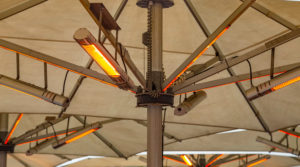
The science behind infrared heaters
Infrared heaters are made with a heating system and a reflector. The heating system converts electric or chemical energy into thermal energy as the reflector directs the generated heat toward the intended room, object, or material.
The key to the energy efficiency of infrared heaters is the type of material used as the reflector. It should have a high reflectivity rate and a low absorption rate. The less heat it absorbs, the more heat can be sent to the right place. Good reflective materials are aluminum, stainless steel, ceramics, and quartz.
Sometimes, the reflectors will be covered in other metals like gold, or ruby, to improve their reflective properties. Reflectors will be shaped in certain ways to ensure the infrared waves of heat flow efficiently outwards without bouncing back.
The heat generated by infrared heaters is unique in that it doesn’t heat the surrounding air. The electromagnetic waves flow unobstructed until they hit their target, and that will be where the heat starts to build.
This means infrared heaters are energy efficient since they don’t waste heat along the way. They’re convenient and normally safe to use since they can be used casually in places like the garage, a living room, a cottage, or a shed. On the industrial side, they’re used for drying, printing, curing, and more purposes.
Leveraging the energy efficiency of infrared heaters
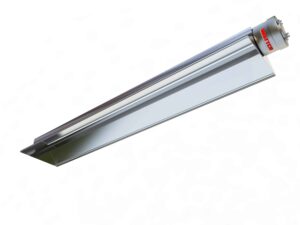 Consider the parameters of your project, whether large or small and see how many of these points line up with your needs:
Consider the parameters of your project, whether large or small and see how many of these points line up with your needs:
- Infrared heaters have minimal heat loss since the ambient air isn’t heated, only the intended target. For example, if a surface or material needs to be dried with heat, an infrared heater can focus on the target as opposed to warming the entire room.
- Where quick heating is necessary, infrared heaters reach their target temperature quickly and send it directly to the target. You won’t have to wait for the whole room to reach the right temperature to know the medium is being heated.
- Infrared heating isn’t harsh; it’s a more natural heat like that which you’d feel from the sun. However, while providing heat, it won’t affect humidity levels, reduce oxygen levels, or evaporate moisture in the air.
- Where moisture is a concern, infrared heaters will help reduce mold and mildew. These growths are inhibited since the moisture’s mobility is limited. This is beneficial in industries working with medicine or food where moisture can ruin the supply.
- If the area is already loud enough, or the area is quiet and must stay that way, infrared heaters are an excellent choice since they don’t produce noise. They don’t use fans, engines, or other noisy components.
- In health-care scenarios, for example, since infrared heaters are electric and don’t use particulates that affect the air, breathing clean air isn’t a concern, and neither is the agitation of particulates, toxins, or allergens in the air.
- On the physical side, infrared heaters don’t dry out the skin and produce new problems. Rather, they help with blood circulation, respiration, pain and inflammation, and quality sleep.
Many of these points are reasons why industries, such as pharmaceuticals, food and beverage, and health care, opt for infrared heaters when needed. There’s such an efficient heat delivery without negative side effects that fragile or health-related processes can operate without concern.
This isn’t to say that industrial settings can’t benefit as well. With direct heating, quiet running, and safe operation, industrial settings can use the heat they need without adding to the ambient temperature.
Wattco’s low carbon footprint products
Much like infrared heaters, Wattco’s other products are already environmentally friendly and energy efficient, with upgrades always underway to continuously provide the best, sustainable products to our customers. Whether you’re looking for infrared heaters, duct heaters, or silicone rubber heaters, check out our products, and contact us with any questions.
There are many different uses and applications for electric heating elements in various processing and industrial manufacturing industries. One of the most common heating elements within this field is electric infrared heaters (interchangeably called “IR” or radiant heaters). Electric heating elements such as these aid manufacturing and industrial processes primarily by maintaining substances (such as adhesives or oil residue) at the correct temperature needed for efficient processing. 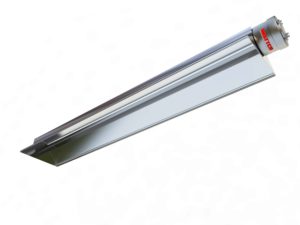 Infrared heaters are ideal for a variety of reasons.
Infrared heaters are ideal for a variety of reasons.
First, the radiant method of heating is energy efficient. This means the electric heating elements have a great spot in the modern, green world.
Second, electric infrared heaters are most helpful in heavy-duty projects that require high temperatures and high intensity.
Third, the specifications and method of heating for electric infrared heaters make the heating elements easy to clean and maintain. As well, they are cost-effective in comparison to other available options.
Finally, infrared heaters are ideal for the industrial sector because they can be applied across many industries, from the medical and automotive industries to the mining, oil and gas industries.
Infrared Heaters
Infrared radiant heaters are also commonly used in industrial settings as space heaters for large areas, such as ice rinks, aircraft hangars, and parking garages. There are two primary forms of electric heating elements: direct heaters and indirect heaters.
Direct immersion heaters, as the name implies, immerse the main heating element directly into the liquid, while indirect heaters conduct heat through radiation or convection. As a result, infrared heaters are considered indirect immersion heaters since the heating element transfers heat to and maintain the temperature of the given liquid. The heater uses radiation, rather than direct contact. In this way, electric infrared heaters are energy efficient, as they transfer entirely electric power into heating the liquid or substance, with very letter energy lost along the way.
Also read: Industrial Heating Methods, Convection or Infrared?
Industrial Infrared Heaters
 Infrared heaters in an industrial setting are heavy-duty units designed to emit high-intensity heat. This is achieved by using tubular elements that can be easily replaced if the needed arises. The tubes of the heating element frequently use quartz elements. This allows them to bear the high temperatures associated with their use. The rest of the heater is usually stainless steel to ensure long-lasting usage.
Infrared heaters in an industrial setting are heavy-duty units designed to emit high-intensity heat. This is achieved by using tubular elements that can be easily replaced if the needed arises. The tubes of the heating element frequently use quartz elements. This allows them to bear the high temperatures associated with their use. The rest of the heater is usually stainless steel to ensure long-lasting usage.
The tubes can also be equipped with waterproof casing to protect the heating element from moisture penetration such as humidity. Electric infrared heaters are usually paired with digital or mechanical controls, making the application of the heating element virtually limitless.
Infrared heaters have begun to be used in the medical field. This is as professionals have realized that the heating elements are effective in separating blood platelets. The heating elements are used in the automotive industry in drying adhesive materials more efficiently, and in the mining, oil and gas industry to clean crude oil tanks. Ultimately, electric infrared heaters are most useful in heavy-duty, high-temperature products. This is because of their efficiency, ease of use and maintenance, and versatility of applications.
Infrared heaters are commonly used in large indoor and outdoor areas that transfer heat energy through electromagnetic radiation. Shopping malls, gymnasium, storage chambers are a few examples where these devices are installed to keep the internal temperature stabilized. The other applications include food stalls and restaurants to keep edible items hot, especially meat made products.
What Is Radiant Heating?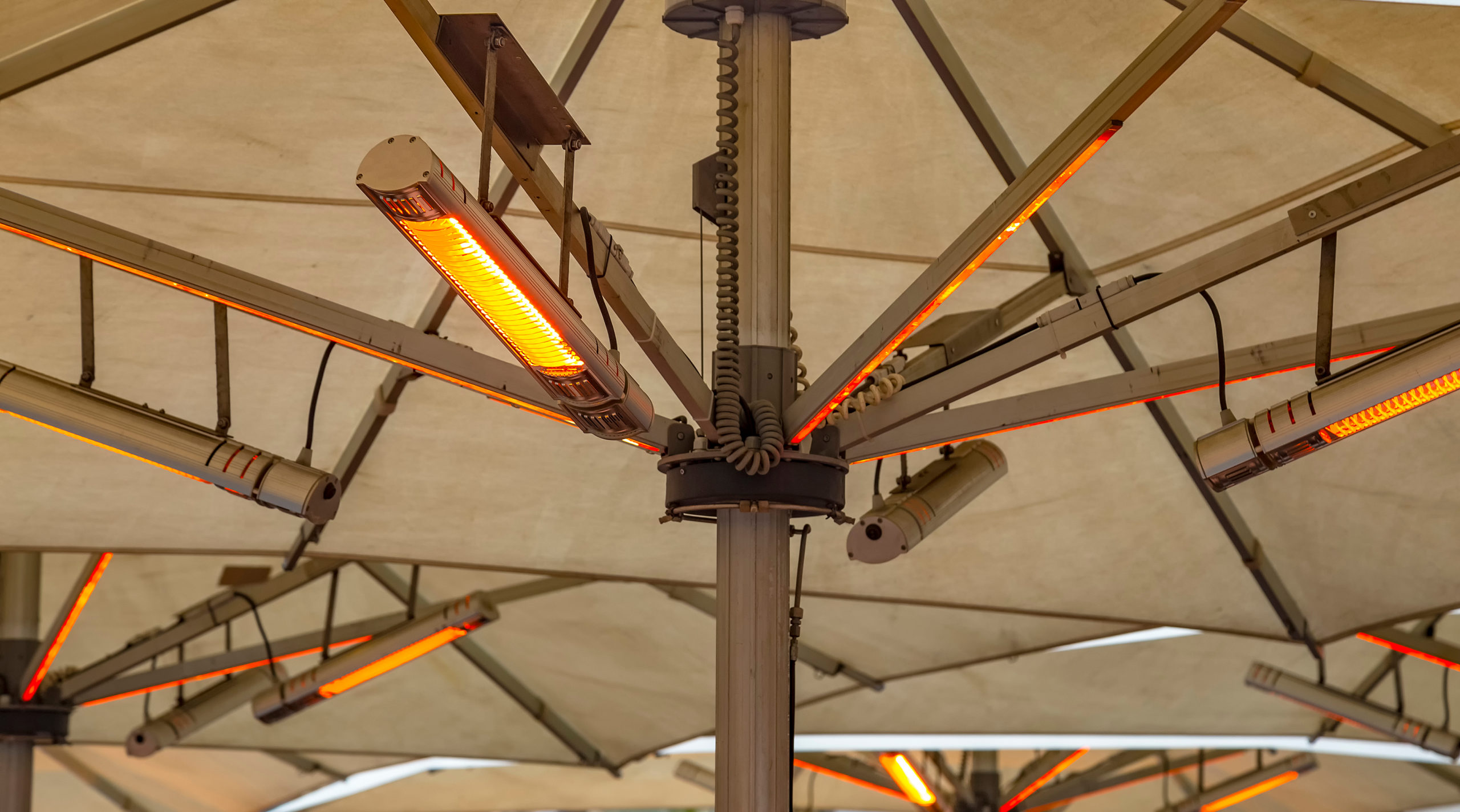
The process to transfer heat energy via infrared heater is known as radiant heating. The heat is similar in nature to that of sunlight, which is why it is also known as a synthetic means to provide warmth.
Technicalities
Different type of these heaters basically vary depending on the wavelength of infrared radiation that ranges from 780 nm to 1 mm. Check out below for classifications.
- Such infrared heating devices that emit heat having visible light are known as shortwave heaters. Their wavelength lies between 780 to 1,400 nm which can easily be observed with a naked eye.
- Medium wavelength ranges between 1,400 to 3,000 nm. Slightly visible from normal eyesight.
- Such heaters having infra-radiation above 3,000 are known as “Far-infrared or dark emitters”. Non-visible to a human eye.
Elements Used
In electrical infrared heating devices, tungsten wire is commonly used as a filament, which is shaped like a coil providing more surface area. Low-quality alternatives for tungsten are carbon, iron alloy, aluminum and chromium. Carbon heats up quite rapidly as compared to other filament materials.
Gold coating over quartz tube is used in infrared heaters during industrial processes, which directly emanate heat towards the targeted product. Gold is considered to have a higher infrared reflective feature and is prone to oxidation.
Applications
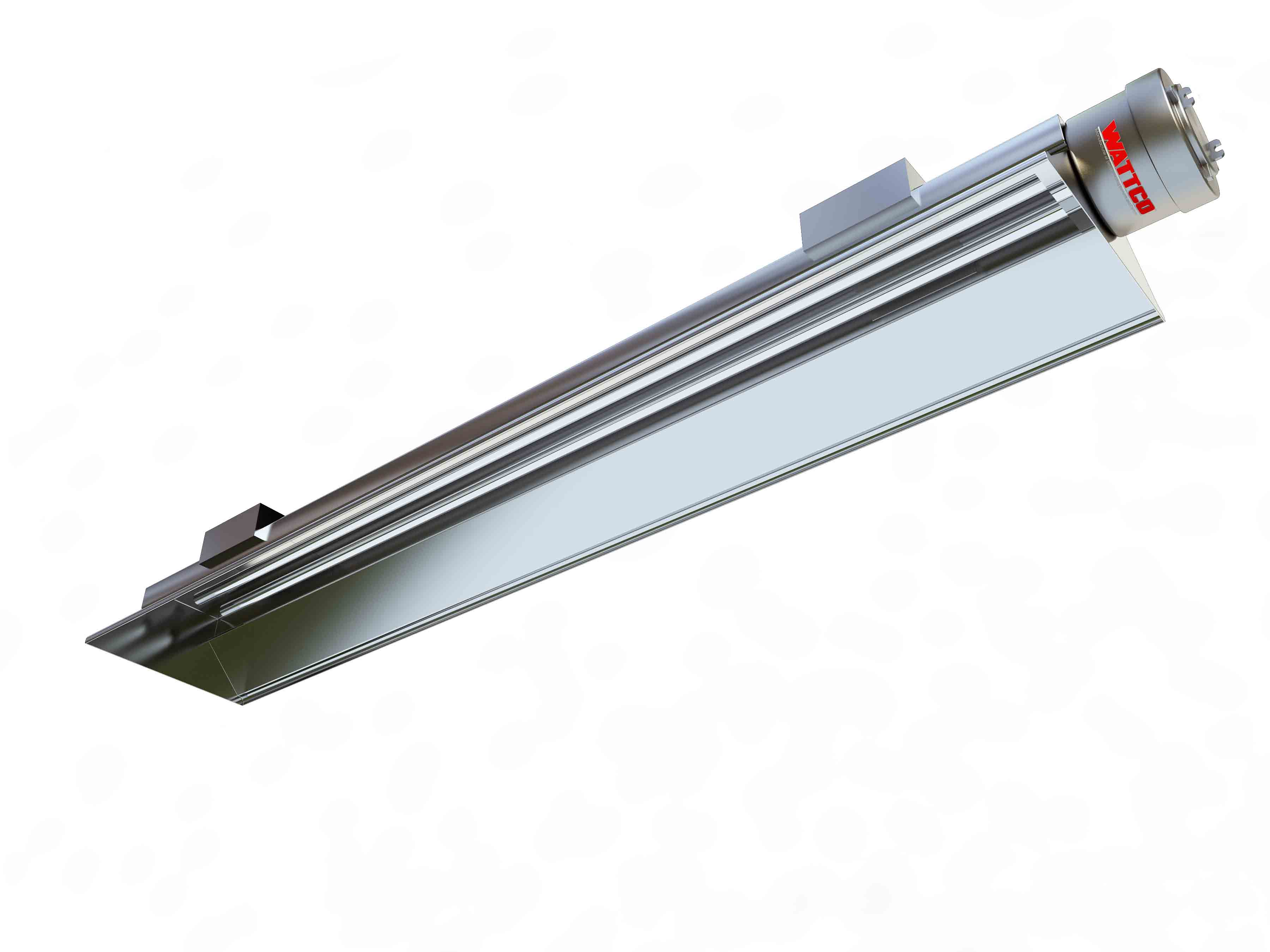 IR heating devices are generally used in the following processes.
IR heating devices are generally used in the following processes.
- For shrinking, welding and heating plastic before giving it a specific shape
- Treating of glass and metal via high temperature
- In cooking
- In zoos, garages and veterinary clinics to provide warmth to tropical reptiles, amphibians and birds
- Curative treatment of coatings
Possible Health Effects
Different tests and experiments were performed over IR heaters and their effects on human skin and health in case of prolonged exposure. Details are given as follows.
- High-intensity shortwave IR radiation causes thermal burn if the device is placed too close.
- Workers and engineers like welders, glass blowers often complain of itching and burning in the eyes.
Common reason for this is the de-pigmentation of iris and weakening of aqueous humor. However, if preventive measures are taken prior getting exposed to the device, you can easily reduce the above-mentioned ailments.
Primary Aspects
Check out below for some of the basic features you will get using infrared heating tools via radiant heating.
- The heat is provided rapidly when device is turned ON. Similarly, it also cools down within moments after powering off.
- Many different sizes, watt densities and filament materials available in market for you to choose from.
All the Benefits You Will Get
Flexible design and outlook for easy handling
- Simple to install, maintain and cleanup without any hassle
- Eco and budget friendly
- Maximum output with minimum heat dissipation
- Easy to carry and attuned to local power outlet
- Long lasting with robust technology
- Anti-corrosive and oxidant
For further details and information, feel free to visit Wattco.com
Infrared and Ceramic heaters stand out as efficient and versatile solutions for providing secondary or primary heating in various residential, commercial, and industrial settings among HVAC (Heating, Ventilation, and Air Conditioning) systems. Knowing the features, advantages, and uses of both ceramic and infrared heaters is crucial as the market for energy-efficient heating solutions expands. This article highlights the key differences between the two heaters which would help you in selecting the heater that fits best for your demands.
What Are Infrared Heaters?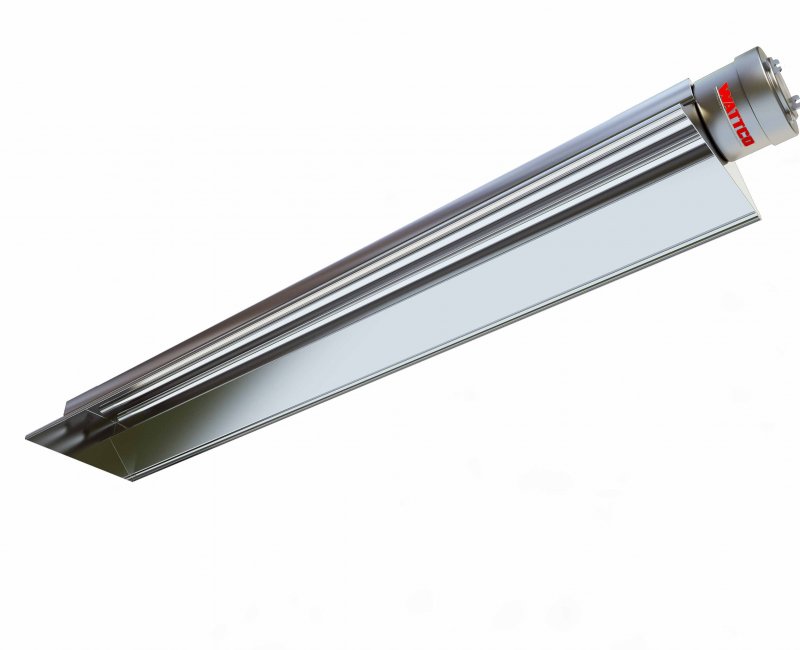
Infrared Heaters ensure rapid and effective warmth by releasing infrared radiation that concurrently heats surroundings. Spaces that are poorly insulated or open spaces employ this method of heating as it does not rely upon heating the air, which escapes easily.
Infrared rays provide instant warmth owing to their direct penetration. These heaters do not rely on air for the transmission of heat and thus help resist wind and drafts Making them great to use in outdoor conditions like lawns, gardens, and garages that require targeted heating.
Major Features:
- Infrared heaters offer quick and effective warmth in the surroundings.
- They convert energy into heat at a greatly optimized and efficient level.
- Infrared heaters are environment-friendly as they maintain natural humidity levels, unlike traditional heaters.
- They are silent in operation and effective in varied environments including windy and drafty areas.
What are Ceramic Heaters?
Ceramic heaters rely on their ceramic heating component to disperse heat and then use a fan to spread the heat around the space. Ceramic fans provide a quick and uniform rise in temperature throughout the space.
Ceramic heaters can provide heat for a substantial amount of time even after being turned off because ceramic can retain heat excellently. This added benefit makes them great for longer and economic uses at home. Ceramic heaters come packed with a ton of safety features to ensure your homes stay perfect.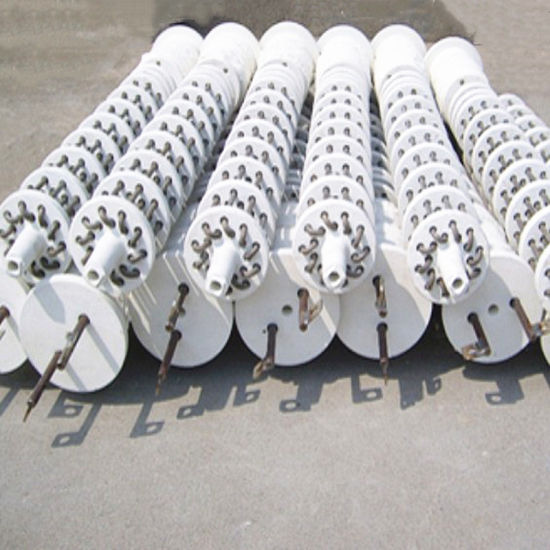
Major Features:
- Ceramic Heaters employ fans to distribute heat around the spaces uniformly and quickly.
- Ceramic Heaters come bundled with safety features including cut-off and tip-over switches preventing your home from unwanted burns.
- Ceramic Heaters are cost-effective devices as they can continue to heat our spaces even when turned off.
- They are available in a multitude of different designs and sizes fitting to the customer’s needs and demands.
Infrared vs Ceramic heater: which one to go for?
-
Energy Efficiency:
Infrared Heaters, relying on their specialized method of heating are seen as a powerhouse in terms of energy efficiency. The method of heating surroundings directly rather than the air ensures minimum energy loss. This energy conversion is almost 100%. This is particularly beneficial in outdoor spaces, large poorly insulated spaces, or areas that require targeted quick heating zones.
Ceramic Heaters rely on a fan to distribute the warm air uniformly that is generated from the heating component. This method offers consistent and systematic heating which results in great energy to heat conversion. This is beneficial for closed-off spaces like an office cabin or a room that can trap warm air and circulate it efficiently.
-
Design and ease of relocation:
Infrared Heaters are available in various designs that include lightweight materials and sleek profiles to fit your spaces and allow relocation. They also offer freestanding units that can be easily placed in different rooms while also providing permanent installations for the same. Models that are used in outdoor settings are designed such that they are resistant to moisture and temperature fluctuations.
Ceramic Heaters are offered in a more compact and portable design in order to provide better adjustments and movements around the space. They are provided with tactical handles by the sides to facilitate ease of relocation. These heaters follow the plug-and-play principle to curb the hefty installation process while also maintaining their aesthetics and sleek profiles of design.
-
Cost-friendliness:
Infrared Heaters’ prices can range anywhere between 50$ and 300$ depending upon the features offered. Since they heat the objects around them directly excel at converting energy to heat, making them the most cost-effective equipment for targeted zones or large outdoor spaces. The operational cost for these heaters can range from $0.06 to $0.36 per hour with almost no maintenance cost.
Ceramic Heaters’ prices can range between 30$ and 100$ depending on design, size, and portability. These heaters come with energy-saving mode out of the box in order to conserve energy and save money. The operational cost can be expected to be somewhere between 0.18$ and 0.30$ per hour. The maintenance cost is considerably low owing to the components and their excellent qualities.
-
Sustainability:
Infrared Heaters are recognized as one of the most environmentally friendly heaters. All because of their specialized heating process they help in reducing carbon footprint and maintaining natural humidity. They also make use of recyclable materials for their manufacturing thus promoting a conscious and eco-friendly view.
Ceramic Heaters use ceramic heating components for generating heat which is also to an extent a pro-environment approach. They do not burn fuel or emit any toxic gases like their traditional counterparts do. Ceramic Heaters are also manufactured using non-toxic and recyclable waste materials to promote environmentally friendly causes.
Conclusion
Ceramic and Infrared heaters both provide a superior and more optimized output when compared to their traditional counterparts. Infrared heaters have been proven to be more useful and appropriate for large outdoor or poorly insulated spaces while ceramic heaters can be best utilized in closed-off smaller spaces that can trap the warm air. Depending upon a fair understanding of the prerequisites of the surroundings, you can decide which heaters fulfill your demands better and make an informed choice.

